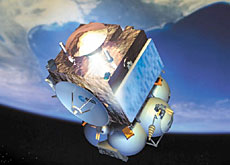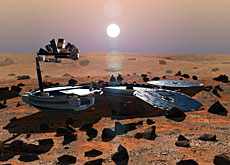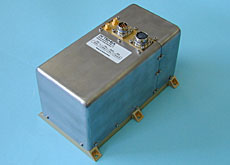Europe heads for the Moon

Europe’s first mission to the Moon has blasted off successfully from the Kourou spaceport in French Guiana.
The Smart-1 spacecraft with a Swiss camera aboard will study the Moon more accurately than ever before.
The main purpose of the mission is to test a new propulsion system, which is more efficient than traditional rocket technology for long distance space journeys.
Smart-1 is very small, measuring just one cubic metre and weighing less than 370 kilograms. When extended, its solar panels span 14 metres.
“The most interesting aspect of this mission is that it tries out a new technology to move around in space,” Johannes Geiss, honorary director of the International Space Science Institute in Bern, told swissinfo.
Solar electric propulsion converts sunlight into electricity via solar panels and uses it to electrically charge heavy gas atoms.
The resulting beam of charged particles accelerates away from the spacecraft at high speed and drives it forward.
The speed at which the gas is ejected makes this technique much more efficient than traditional chemical rockets where the burning fuel creates gases which are expelled relatively slowly.
The technology has only been used once before on an interplanetary mission by the US space agency, Nasa.
Moonstruck
After a conventional launch on an Ariane-5 rocket, Smart-1 will use its ion engine to overcome the Earth’s gravity and put it into orbit around the Moon.
If all goes well, such a system could provide the propulsion for future European missions into deep space such as BepiColombo, which is due to head to the planet Mercury at the end of the decade.
After 40 years of Soviet and American lunar exploration, knowledge of the Moon’s surface is still incomplete.
The most fashionable theory is that about 4.5 billion years ago, a huge object collided with the young Earth, flinging up debris which later merged to form the Moon.
If the story is right, the Moon should contain less iron than the Earth in proportion to lighter elements such as magnesium and aluminium.
By measuring the relative amounts of these chemical elements comprehensively for the first time, Smart-1 should provide the answer.
“There are still some very useful questions to be asked about the Moon,” said Geiss.
Over the Moon
After a 16-month journey, Smart-1 will finally operate in an orbit 300-10,000 kilometres above the Moon.
Images taken from many different angles and X-ray and infrared detection will allow scientists to draw up new three-dimensional models of its surface.
These will provide clues about its chemical composition and origins. The miniaturised camera developed by the Neuchâtel company, Space-X, will assist in this task.
“It will be a demonstration for the next generation of camera instruments for space exploration,” said Jean-Luc Josset, director of Space-X.
But Swiss involvement in the project does not end there. The spacecraft’s aluminium shell, weighing just 42 kilograms, was designed and built by APCO Technologies in Vevey, western Switzerland.
Zurich-based Contraves Space was involved in the construction of the revolutionary propulsion system.
Lunar surface
Any water on the lunar surface would be very helpful in the creation of permanent bases on the Moon.
Propulsion by an ion engine is not the only innovative technology on Smart-1.
It is also testing out a system that will allow spacecraft to navigate on their own through the solar system and will try to establish a communication link with the Earth using a laser beam.
The lunar probe should have left Earth in March but its take-off was postponed following a failed rocket launch last December.
Switzerland is a founding member of the European Space Agency and contributed SFr125 million ($91 million) to its budget in 2002.
swissinfo, Vincent Landon
Smart-1 measures one cubic metre and weighs 370 kilograms.
Its solar panels span 14 metres when deployed and provide 1.9 kilowatts of power.
The scientific instruments weigh just 19 kilograms.
The probe’s orbit around the Moon will range from 300 to 10,000 kilometres.
Smart-1 is the first European spacecraft to travel to and orbit around the Moon.
It will test a revolutionary propulsion technique – only used once before by Nasa.
Smart-1 will look for water (in the form of ice) on the Moon.
It will make the first comprehensive inventory of key chemical elements in the lunar surface.
It will investigate the theory that the Moon was formed following the violent collision of a smaller planet with Earth, 4.5 billion years ago.
Smart stands for Small Missions for Advanced Research and Technology.

In compliance with the JTI standards
More: SWI swissinfo.ch certified by the Journalism Trust Initiative



You can find an overview of ongoing debates with our journalists here. Please join us!
If you want to start a conversation about a topic raised in this article or want to report factual errors, email us at english@swissinfo.ch.